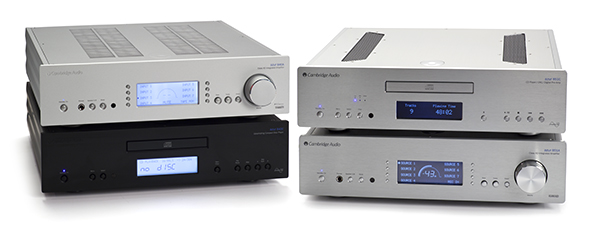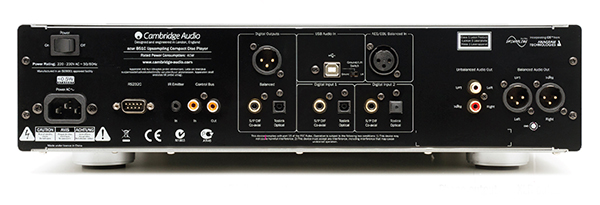The Latest Flagship Components From Cambridge Audio

No matter what you own, it’s usually unnerving when a “new model” hits the market.
Especially so with hifi gear. And certainly if you just bought the previous model just before the newest, latest, greatest arrives. I feel your pain.
The most agonizing questions are “Should I trade up?” “Immediately?” “Is what I own now rubbish?” “Is the new thing really better?” Maybe, not necessarily, definitely not, and yes. As a current Cambridge owner, I’m always impressed with the effortless way their products work. They are logically designed from an electrical and ergonomic standpoint; while the manuals are well written, you can turn these components on and start listening without reading them. Best of all, both components share the same remote, allowing those of us a bit more on the OCD side the opportunity to keep one tucked away, looking pristine.
I’m a sucker for understatement, and Cambridge’s US importer, Daniel Jacques is a smart guy. When discussing the review of the new CD player and integrated, as he was telling me about the new features, decided it would be an excellent idea to send me the past models so I could directly compare them. “You’ll see for yourself the progress we’ve made on the new units, even though they look almost the same.” He said with a smile. Other than a few more buttons on the CD player, you’d never know the difference. Not that I condone this kind of behavior, but these are stealthy enough to sneak right in without anyone knowing the wiser. If you get caught, this review will self-destruct.
An audio omen
During the photo shoot, it appears our Canadian friends have given us a gift. Mickey Hart’s At The Edge is in the CD tray of the 851C. Very familiar with this disc, why not start the comparison right here? Both pairs of Cambridge components were plugged in and powered up for 24 hours before serious listening began. The third track, “Slow Sailing,” features a thunderous bass line that begins a bit loose, so amplifiers with no grip go to pieces here. The new amplifier jumped right out in front in a major way, driving the German Physiks Unlimited mk.II speakers (also in for review), with more weight, more grip and more speed in the bass region than the 840A. This is a gun demo disc to play really loud if you have the juice, because it sounds so tribal, with the drums having a big, bold sound. Veteran drummer Hart blends in a myriad of exotic percussion instruments, filling the soundstage in all three directions.
The German Physiks speakers are a great place to start, because the proprietary DDD driver is fast, clean and accurate, much like an ESL. The bottom line is garbage in/garbage out, and most modestly priced amplifiers can’t cut the mustard with these speakers. With the $30k Burmester 911 and $65k Octave Jubilee monoblocks now taking a back seat, my informal listening associates were all duly impressed with the amount of finesse the 851A brings to the table. Even more impressive for the MSRP of $1,849, up from the $1,495 commanded by the 840A it replaces)
Power to drive
Almost all listening was done with the German Physiks Unlimited IIs, a pair of Dynaudio Confidence C1 IIs, the new KEF LS50s and my recently restored Acoustat 1+1s – notoriously tough to drive. Even with the Acoustats, the 851A breezes through. It’s no surprise that the two most demanding speakers in the group (the 1+1s and the Unlimiteds) reveal the upgrades to Cambridge’s XD amplifier circuit and increased power supply capacity to the fullest.
Don’t be confused by the moniker: XD does not denote a class D amplifier under the hood of the 851A. XD refers to “Crossover Displacement,” the way that Cambridge has finely tuned the crossover point of their amplifiers transitioning from Class A at low power to AB at higher power. The 851A also takes advantage of a massive toroidal power transformer – you’ll notice the weight as you unpack it.
The 840A and 851A both claim a power output of 120 watts per channel into an 8-ohm load and 200 watts per channel into a 4-ohm load – enough for all but the most inefficient speakers. Either will drive a pair of Magnepan 1.7s to modest level with decent grip, but the newer amplifier does a better job, where the 840A seems to struggle a bit.
This amplifier is well composed at all volumes, yet at modest volumes, where it stays more in Class-A bias, it’s easy to think you are listening to a much more expensive amplifier indeed.
 The ins and outs
The ins and outs
One of the 851As best features is its plethora of inputs and outputs. There are five strictly RCA inputs, with input 1 and 2 having the option of balanced XLR or standard RCA inputs. And, for the true analogaholic, a tape monitor loop. Those using a powered sub woofer or wishing to bi amp are also rewarded with a variable output. (RCA) Cambridge has also thoughtfully supplied a standard RS-232 port, an extension for the IR remote and their own control bus, so that you can link an all-Cambridge system together. Two sets of speaker outputs, switchable from the front panel make it easy to increase the flexibility of a system based on the 851A and those with stacked Advents.
Cambridge’s newest version of their “silicon gate” volume control tracks true and features precise volume control in small increments. They also claim extremely accurate channel balance with this volume control. Best of all, the front panel includes a bass and treble control. Purists will freak, but music lovers will love them. Just like the ones on my Cambridge 740A, they can be switched out when not in use, but work very well, providing only modest adjustment at the extreme ends of the audio spectrum. These are especially good if you decide to use your 851A to anchor a high quality two-channel system for video playback as I do.
Headphone listeners will be pleased with the onboard headphone amp. With a wide range of phones from the Grado 60i, all the way up to the LCD-2 (a range of about $100 – $1,000), the internal amp is on par with anything you’ll find externally for a couple hundred bucks. Not a bad thing to include on the chassis. Those who haven’t partaken the pleasures of the head-fi world will find the 851A a great place to start your journey.
The front panel is well laid out and much like the Porsche 911; the control layout is similar from one generation to the next. Those encountering the Cambridge marque for the first time will find the 851A and 851C well thought out, and not requiring the remote for most functions. The large alpha numeric display is easy to read, and you can tailor the display to your inputs, so instead of reading “input 1” and “input 5,” they read “CD player,” “DAC,” or whatever you’d like to label them.
 CD Player surprises
CD Player surprises
While the 840A and 851A have virtually identical specs, their companion disc players are more dramatically different. They each upsample digital data from the digital inputs and CD drive to 24bit/382khz, the 851C goes further, with its new, ATP2 upsampling, which is said to further reduce jitter over the previous Q5 upsampling system implemented in the 840C. In addition to a refinement of the prior system, ATP2 offers three distinct digital filter choices: A Steep roll-off filter, A Linear Phase filter and a Minimum Phase filter, to optimize digital playback better towards your personal taste and software. The 851C has the same price jump ($1,499 to $1,849) I suggest experimenting with the different filter options, but be warned, it can make you a bit mad, trying to figure out which one is the best choice.
Much like the amplifier, the newer 851C offers more refinement, however here we found the major gains more in HF smoothness and low-level detail. Reproducing acoustic instruments is a strong suit of the 840C, yet the 851C improves this aspect of digital reproduction significantly. The opening drum rolls on the Pretenders “Private Life,” from their self-titled album have more attack and more immediacy, while the bells in the background linger and decay more delicately. The oboe is also reproduced with more texture via the newer player, tracking through the Netherland Wind Ensemble’s Greatest Hits.
While quick A/B comparisons reveal the improvement in the new player quickly, perhaps the most dramatic difference happens after listening to one player for about an hour, then making a quick switch to the other. The soundstage shrinks noticeably going from 851C to the 840C, and when going in the other direction, things definitely have more vitality and immediacy.
As both players can be used as a DAC, high-resolution files again shine brighter on the new model. A sequence of female vocal tracks in 24/96 and 24/192 formats from Dusty Springfield, Carole King and Bjork all illuminate more resolution on tap. Interestingly enough, the 851Cs ability to navigate Janis Joplin’s voice on Pearl is the most telling of the new players capability. Much like a violin being butchered on a budget player, Joplin’s raspy voice translates with more body and ease on the 851C. Both players do a commendable job illustrating the difference between high res files and standard 16bit/44.1khz files, but the 851C makes it clearer.
Whether you consider it the most interesting change or the most useful, the 851C now offers a precise digital volume control and variable outputs. Three sets of digital inputs, offering a choice of balanced AES/EBU, S/PDIF co-axial and Toslink optical as well as a separate USB input (with a switchable ground lift) makes the 851C the perfect hub for the music lover that has no interest in analog sources, this makes the 851C a killer value. Connect your favorite power amplifier and roll. Its single ended RCA and balanced XLR outputs make it compatible with any amplifier.
We had excellent luck with tube and solid-state examples. The combination of the 851C and the new Prima Luna ProLogue Premium power amplifier with 40 watts per channel of tube power along with the KEF LS50s proves beguiling in a small room, albeit not as powerful as the companion 851A. Either way, it’s nice to have the option.
For those not wanting a rack full of gear, the 851C had no problem driving a 6 meter length of XLR or RCA cables to a handful of power amplifiers we had on hand. There were no issues with HF rolloff or output drive. A simple menu click enables the variable output. And like the 851A, the inputs can be labeled via the remote.
Refinement is the word
If you currently own an 840A and 840C, you still possess some great gear, and depending on the speakers you’ve paired with this combo, you may not feel the urge to make the move to the next models. However, those taking the plunge will not be disappointed, there is enough of a delta to rediscover your current music collection without guilt. This is a great pair, offering high performance and enough power to drive almost any speaker with headroom to spare.
For those starting from scratch, the Cambridge Audio 851A and 851C deliver high performance, excellent functionality and understated good looks. We call that an “exceptional value” and I am happy to award these two components our first Exceptional Value Awards of 2013.
The Cambridge Audio 851A integrated amplifier and 851C Disc Player/DAC/Digital Preamplifier
$1,849 ea.
www.cambridgeaudio.com (mfr)
www.audioplusservices.com (US importer)
www.plurison.com (Canadian importer)


